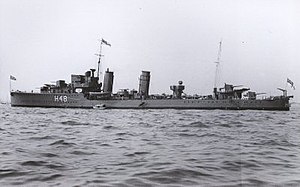
| |
| History | |
|---|---|
| Name | Crescent |
| Ordered | 30 January 1930 |
| Builder | Vickers-Armstrongs, Barrow-in-Furness |
| Laid down | 1 December 1930 |
| Launched | 29 September 1931 |
| Completed | 15 April 1932 |
| Commissioned | 21 April 1932 |
| Fate | Sold to Royal Canadian Navy, 20 October 1936 |
| Name | Fraser |
| Namesake | Fraser River |
| Acquired | 20 October 1936 |
| Commissioned | 17 February 1937 |
| Identification | Pennant number H48 |
| Honours and awards | Atlantic 1939-40 |
| Fate | Sunk in a collision with HMS Calcutta, 25 June 1940 |
| General characteristics as built | |
| Class and type | C-class destroyer |
| Displacement |
|
| Length | 329 ft (100.3 m) o/a |
| Beam | 33 ft (10.1 m) |
| Draught | 12 ft 6 in (3.8 m) |
| Installed power | 36,000 shp (27,000 kW) |
| Propulsion |
|
| Speed | 36 knots (67 km/h; 41 mph) |
| Range | 5,500 nmi (10,200 km; 6,300 mi) at 15 knots (28 km/h; 17 mph) |
| Complement | 145 |
| Armament |
|
HMS Crescent was a C-class destroyer which was built for the Royal Navy in the early 1930s. The ship was initially assigned to the Home Fleet, although she was temporarily deployed in the Red Sea and Indian Ocean during the Abyssinia Crisis of 1935–36. Crescent was sold to the Royal Canadian Navy in late 1936 and renamed HMCS Fraser. She was stationed on the west coast of Canada until the beginning of World War II when she was transferred to the Atlantic coast for convoy escort duties. The ship was transferred to the United Kingdom (UK) in May 1940 and helped to evacuate refugees from France upon her arrival in early June. Fraser was sunk on 25 June 1940 in a collision with the anti-aircraft cruiser HMS Calcutta while returning from one such mission.